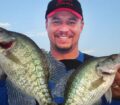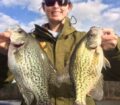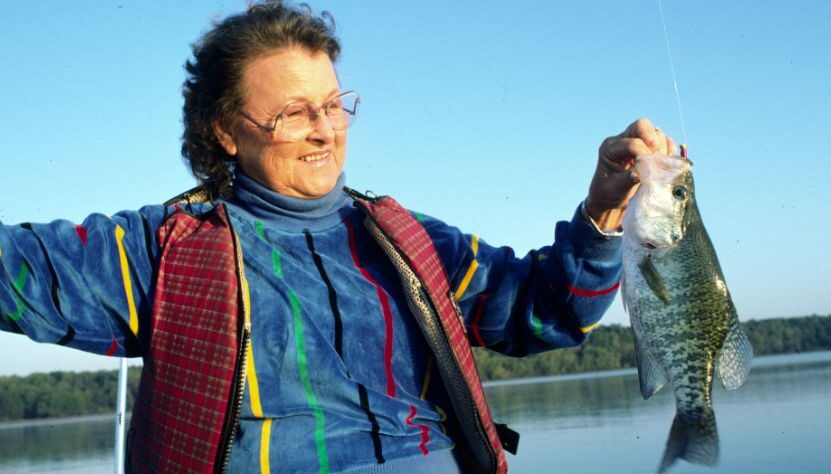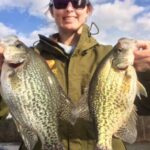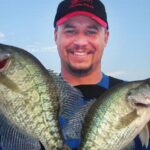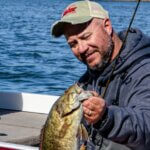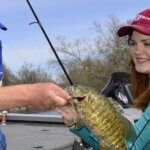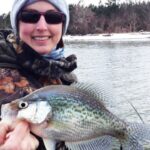Editor’s Note: Brad Whitehead of Muscle Shoals, Alabama, has guided crappie for 23 years in northwest Alabama on the Tennessee River, Wilson and Pickwick lakes, and a small chain of lakes called the Bear Creek Development Authority. A day or two before he has clients, he’s in contact with two or three other fishermen in each area to learn which lake is producing the best. Whitehead’s information on fishing for crappie in February depends primarily on the water’s temperature. You can use that information to adapt your fishing for crappie to where you live and fish. You can contact Whitehead at 256-483-0834 or [email protected]. You can also check out his Facebook.
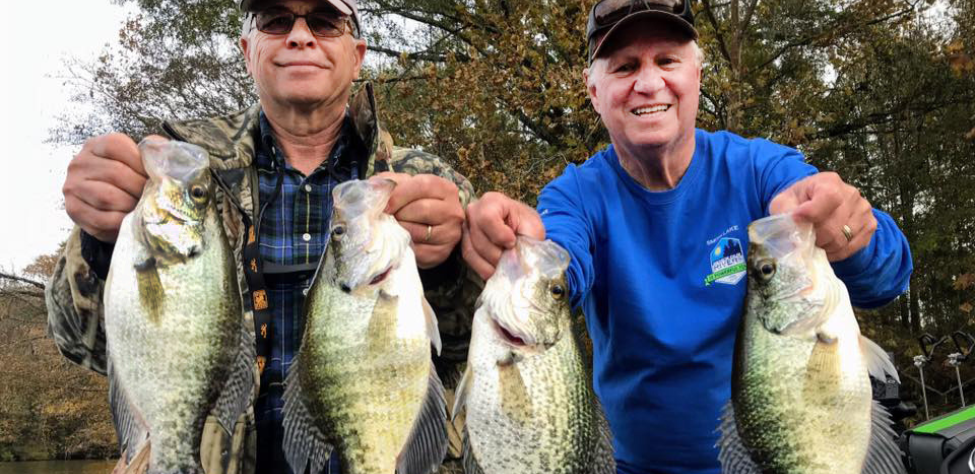
John E. Phillips: If you’re going to fish this February, what lake would you go to, how would you rig, and how would you catch your fish?
Brad Whitehead: In years past, I side-pulled my boat (trolling with a trolling motor on the side of the boat and pulling the boat sideways) so that all the anglers would be fishing new water only. However, in the last two years, I’ve changed my technique. I’m fishing out of a 2170 War Eagle, a 21-1/2-foot aluminum boat. I’m pushing jigs off the front of the boat and pulling jigs off the back of the boat. I’ll probably be fishing Wilson Lake, primarily if we don’t get rain.
I rig a 1-ounce lead egg sinker. I also take two bobber stoppers, like you’ll use when fishing with a cork, and use those bobber stoppers to peg my weight to the line. I want my eggsinker to be about 2 feet above my jigs. I like a Charlie Brewer Slider jig that’s 2-1/8 inches long. It’s a double-action plastic grub that produces plenty of action at this time of the year.
I’m often asked, “Why are you putting the weight above the jig?” I’m trolling very slowly when I’m fishing this way. For instance, I may be fishing for crappie in 25 feet of water, and the crappie will usually be holding 2–3 feet off the bottom.
I fish with baitcasting reels to count my lure down to 23 feet. So, using this rig, I’ve got my jig in the crappie’s strike zone the whole time I’m trolling. I mark 1 foot on my rod and the rods that my customers use. Then my customers and I can pull out whatever depth we want to fish at by pulling 1 foot of line off the reel at a time. By fishing like this, I know my jig is within a foot of the depth where the crappies are holding. Then the crappie will strike it.
During February, I’ll be trolling at .03 to .04 mph. Sometimes we’ll find suspended crappie in 14 feet of water. So, by having that 1-ounce weight on my line, if I pull out 13 feet of line, I know that my jig will be running just above the crappie.
Most people think you have to fish light lines and small jigs to catch crappie in the winter months, but I didn’t go to that school. I prefer heavy line and heavy tackle. I know when I tell my customer to pull off so many feet of line that his or her jig will be running in the strike zone of the crappie – whether they’re suspended or holding near the bottom.
I like a 10-pound clear or low-vis line. My preference is the Vicious 10-pound test line. I put out treetops and stake beds to create a habitat for crappie. On Wilson Lake, some areas have natural stumps. If a customer hangs up his jig on a 10-pound test line, he or she can pull on that line, straighten the hook out, and keep from losing his jig.
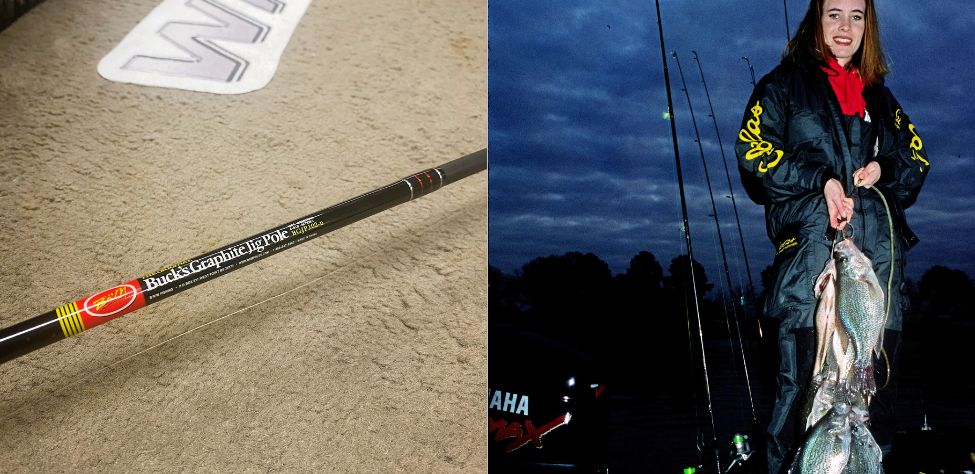
I like 1/8-ounce jigheads in red or pink. I also like black-and-chartreuse grubs or blue-and-white grubs. We’ll often mix up the colors. If I’ve got two customers fishing off the back of my boat, each customer will have four rods. In front of the boat, I’m pushing six rods, three on both sides of the boat. With as many rods and jigs as we have in the water, we’re allowing a lot of crappie to bite and go home to dinner with us.
In the back of the boat, I prefer to fish 10-foot B‘n’M Buck’s Graphite jig poles. On the front of the boat, I’m using 12-foot Buck’s Graphite jig poles. The 10-foot rods we’re fishing on the back of the boat keep the jigs away from the boat’s motor. I’ll use a 12-foot jig pole in front of my boat. Then the crappie see the jig before they heard my trolling motor. I like a Pflueger Echelon Baitcast reel on my poles.
The slowest I’ll troll is .03 mph, and the fastest I’ll troll is .05 mph. Most days, I’ll start off fishing for crappie slowly. If I troll 200–300 yards and don’t get a bite, I’ll increase the speed. Another way I’ll determine whether or not I should go fast or slow is when I’m turning my boat; the jigs move somewhat faster than when I’m pulling those jigs straight ahead. If I catch more crappie then that tells me that the crappie may want to see the jigs moving faster. But I’ll say nine times out of 10, I won’t be using .05 mph on my trolling motor. In February, the water’s cold, and the crappie aren’t going to move very far to chase bait.
Looking for more content? Check out our YouTube channel and watch “How to Catch Crappie in the Wind” by John E. Phillips.
Expert Guidebooks on Crappie Fishing: Best Sellers
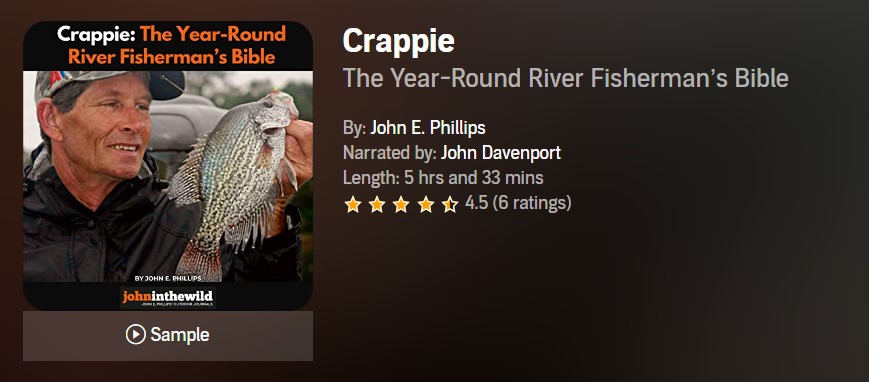
Fishing rivers for crappie and being able to find and catch speckled sides consistently has long been one of the mysteries in the crappie-fishing world.
“One of the reasons that river systems are so difficult to fish is because the water’s either rising or falling in them,” says Ott DeFoe, the 2019 Bassmaster Classic champion.
Rivers also are very susceptible to floods and droughts and constantly have current moving through them. Often fast current or slow current in rivers is created by rain or droughts upstream. When rivers flood, they can wash away fish habitat like logs, sunken trees, manmade brush piles and stake beds. But that’s the time when a river also creates new crappie hot spots that haven’t been available to the crappie or the fishermen before the flood.
Because river systems are so unpredictable, I’ve felt the best way to get the most useful information on how to fish rivers for crappie is to talk to numbers of anglers all over the nation to learn their best tactics.
In this book, I’ve gleaned crappie-fishing wisdom from three dozen crappie anglers and guides from a dozen states, who consistently catch crappie at all times of the year. The tournament crappie fishermen in this book fish most of the country at different times of the year on various river systems and lakes. And, these anglers use techniques you never may have considered, including:
- Setting up a casting ring with your electronics to keep you from getting too close to the crappie that are holding on underwater structure, while you’re fishing all the way around the structure;
- Buying an automotive laser temperature gauge to measure water temperature
- Evaluating the most-productive places to sink brush and other structure, according to prevailing wind direction, the crappie’s summer, fall, winter, and spring migration patterns, and other factors.
VERSIONS: AUDIBLE, KINDLE & PRINT
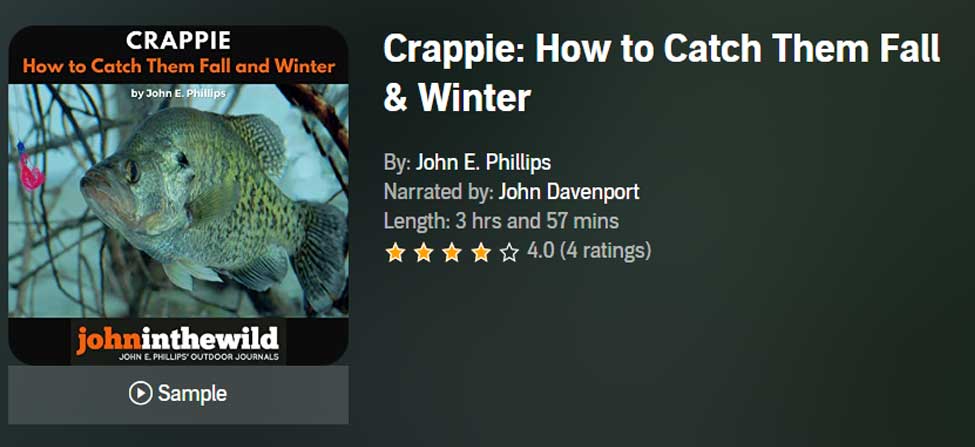
Crappie: How to Catch Them Fall & Winter
Yes, you can catch and eat crappie during the fall and winter months. Often, at many places, you’ll catch more and bigger crappies in the fall and winter than you do in the spring and summer. To learn where to find and how to catch cooler weather speckled sides, we’ve interviewed a wide variety of some of the nation’s best tournament crappie fishermen and guides.
Many of the individuals you’ll hear about in this audiobook are tournament crappie pros who travel the country to fish in crappie tournaments from New York to Florida and from Virginia to California. They use the latest crappie-finding equipment, the best poles, rods, reels, line, and the most-productive baits. Each of the people mentioned in this book has the ability to be dropped out of an airplane anywhere in the United States and catch crappie on any lake close to where they land that contains crappie.
From over 50 years of crappie-fishing experience, I’ve learned that you get the best advice by interviewing a large number of people who have different tactics and fish under various water, weather, and fishing-pressure conditions.
In this book, you will learn:
- How to spider-rig (slow-troll), which is one of the fastest-growing techniques for catching the most and biggest crappies in the shortest time
- How to catch crappie on crank baits and when and where using a crank bait is the most appropriate
- How to find areas of any lake that will hold large schools of crappies during the winter months – places you can return to time and again and expect them to be there
- Why competing in crappie tournaments is one of the quickest ways to learn how to catch more and bigger crappie faster
- Why and how to look for and catch the biggest crappie in a lake
VERSIONS: AUDIBLE, KINDLE & PRINT
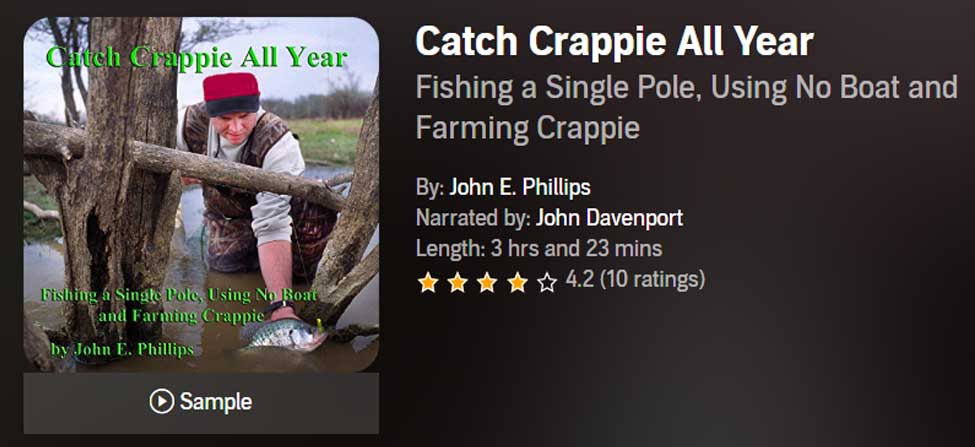
Catch Crappie All Year: Fishing a Single Pole, Using No Boat, and Farming Crappie
I’ve interviewed some of the best crappie fishermen in the nation for my new audiobook, Catch Crappie All Year: Fishing a Single Pole, Using No Boat and Farming Crappie to learn how, where, and when to catch the most crappie with or without a boat while single-pole fishing. I’ve also included information on how to grow a crop of crappie to catch every day of the year. Although I’ve fished in fully rigged crappie boats costing $45,000 – $90,000-plus that can have up to 16 rods at one time to slow troll, I still enjoy….
- Watching a quill cork sink in a brush top
- Fishing with an ultralight spinning rod
- Reeling jigs or minnows along a grass line and feeling that thud when a crappie takes the bait
- Fishing with family and friends, even if we all can’t fit in one boat
- Participating in less-expensive and hassle-free yet highly-productive crappie fishing like single poling
I’ve tried to capture in this new audiobook the old way of crappie fishing with new twists and detailed tactics to aid you in catching crappie all year.
VERSIONS: AUDIBLE, KINDLE & PRINT
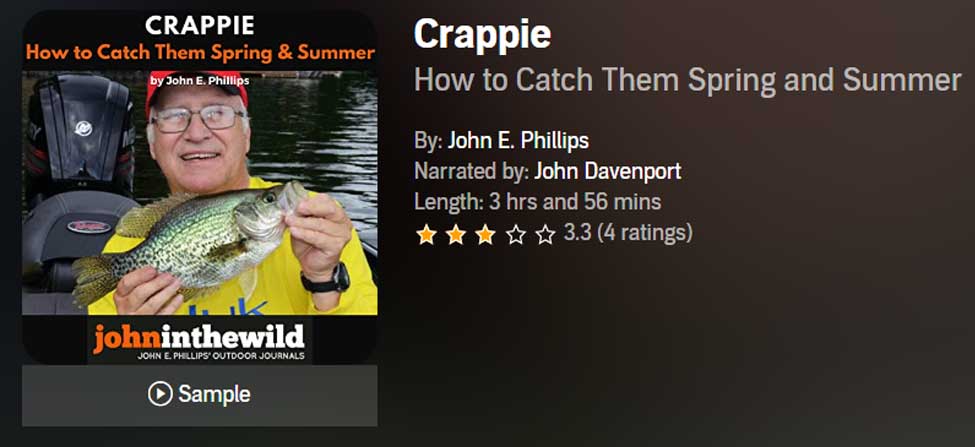
Crappie: How to Catch Them Spring and Summer
You can catch crappie all year long if you know where to find them and what techniques to use to catch them. However, crappie fishing is so technical these days, and we’ve learned so much about how to crappie fish because of the professional crappie-fishing circuits, that one book can’t hold all the information.
This book is the first of a three-part series on how, where, and when to catch crappie, with the best crappie fishermen in the nation. Many of these men have proven they are the best, because they’ve won crappie-fishing tournaments or been successful fishing guides for many years.
This audio version of Crappie: How to Catch Them Spring and Summer includes crappie pros like Ronnie Capps, who has won seven national championships and over $1 million with his partner Steve Coleman.
We also have Malcolm Lane, Stokes McClellan from North Carolina, Billy Blakeley from Reelfoot Lake, John Woods, Kent Driscoll, fishing biologist and professional basser Ken Cook, and many others. We asked the questions that crappie fishermen want answered about how to find and catch crappie during the spring and summer months, and these fishing tips are the result.
In the world of crappie fishing, no one man knows it all, and that’s why I’ve interviewed so many fishermen, asked so many questions, and tried to get so many answers for you about how to fish.
VERSIONS: AUDIBLE, KINDLE & PRINT
Tomorrow: Learning to Catch February Crappie

